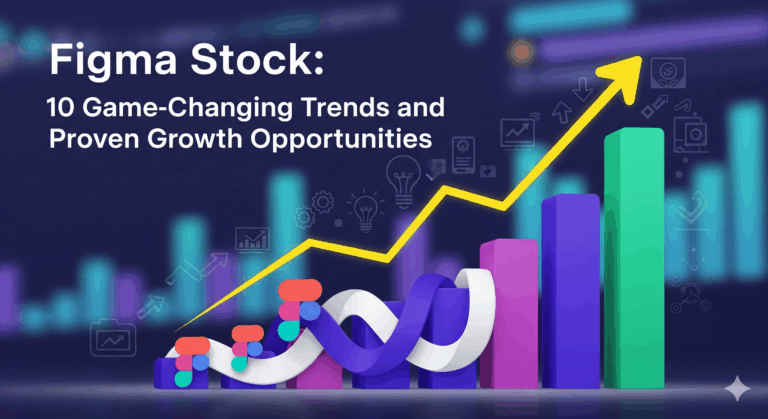
Are you looking for investment, pitch your idea with us!
The design world has experienced a revolution in the past decade, with collaborative, cloud-based platforms replacing outdated design software. At the heart of this revolution is Figma, a powerful web-based design and prototyping tool that has redefined how designers, developers, and businesses collaborate on digital products.
As Figma continues its growth journey and strengthens its market presence, investors are asking an important question: What does the future hold for Figma stock?
In this article, we’ll explore 10 game-changing trends and proven growth opportunities that make Figma a potential leader in the design technology sector—and why its stock is catching the attention of both designers and investors worldwide.
1. The Shift to Cloud-Based Design Tools
Traditional design tools like Adobe Photoshop and Illustrator were installed locally on desktops, limiting real-time collaboration. Figma changed the game by embracing the cloud-first model, allowing multiple team members to work on the same file simultaneously.
This cloud-native approach aligns perfectly with the remote and hybrid work trend, which continues to dominate the global workforce. As businesses prioritize collaborative tools, Figma stands to benefit significantly—boosting its revenue streams and stock potential.
2. Increasing Adoption Among Enterprises
Initially, Figma gained traction among freelancers and small design teams, but now, large enterprises are adopting the platform. Companies like Microsoft, Uber, Zoom, and Spotify use Figma for design and prototyping.
Enterprise adoption means larger contracts, recurring subscription revenue, and higher customer lifetime value, all of which translate into sustainable growth for Figma’s business—and long-term strength for its stock.
3. Expansion into New Markets and Segments
Figma started as a UI/UX design tool, but its scope is expanding:
- Figma Jam (whiteboarding) competes with tools like Miro and MURAL.
- Developer handoff features reduce reliance on third-party tools like Zeplin.
- Prototyping and collaboration tools are appealing to product managers and marketers.
By expanding beyond traditional design, Figma positions itself as a multi-segment platform. This diversification increases its addressable market and provides multiple growth avenues for investors to consider.
4. Integration with Existing Workflows
Figma’s success lies not only in its features but also in its seamless integrations. From Slack and Microsoft Teams to Jira, Notion, and GitHub, Figma integrates smoothly into existing workflows.
This integration ensures higher user retention, as employees don’t need to leave their workflow ecosystem. Strong retention leads to predictable recurring revenue, a factor that investors always look for in growth stocks.
5. Community-Driven Ecosystem
Figma has fostered one of the strongest design communities worldwide. Designers share templates, plugins, and educational resources through the Figma Community Hub.
This community-driven growth model creates:
- Free marketing and brand advocacy
- Lower customer acquisition costs (CAC)
- Network effects where the more people use it, the more valuable it becomes
For investors, this ecosystem translates into a sustainable competitive advantage that’s hard for competitors to replicate.
6. Competitive Edge Against Adobe
Adobe, the long-time design software leader, attempted to acquire Figma for $20 billion in 2022, a deal that ultimately faced regulatory hurdles.
This acquisition attempt highlighted two key points:
- Adobe saw Figma as a major threat to its dominance.
- Figma’s valuation and market demand are strong indicators of investor confidence.
Even without the acquisition, Figma continues to carve out market share from Adobe by offering a more collaborative, cost-effective, and cloud-friendly alternative.
7. Growing Role in Remote and Hybrid Work
Since the pandemic, remote and hybrid work models have become permanent in many industries. Figma’s collaborative tools are tailor-made for distributed teams who need real-time design and brainstorming capabilities.
The more companies embrace remote work, the more essential Figma becomes. This growing dependency is a long-term bullish signal for investors considering Figma stock.
8. Potential for Monetization Expansion
Currently, Figma generates revenue primarily from subscription plans (Free, Professional, and Organization). However, the company has massive opportunities to expand monetization, including:
- Premium plugin marketplaces
- Advanced AI-powered design assistance
- Enterprise-level customization features
- Training and certification programs
These new revenue streams could accelerate top-line growth and create additional shareholder value.
9. Strong Leadership and Vision
Figma’s co-founder and CEO, Dylan Field, has been praised for his vision and leadership. He successfully positioned Figma not just as a design tool, but as a collaboration platform at the center of product development.
Strong leadership is critical for sustained growth, and investors tend to favor companies led by founders with a long-term vision. With Field’s leadership, Figma is well-positioned to innovate continuously and stay ahead of competitors.
10. The Rise of AI in Design
Artificial Intelligence (AI) is transforming every industry, and design is no exception. Figma has the potential to integrate AI-powered features such as:
- Automated wireframing
- Intelligent design suggestions
- AI-generated templates
- Accessibility and usability recommendations
AI adoption would increase efficiency for users and open up new monetization opportunities, further driving stock value.
Why Figma Stock Is Worth Watching?
When analyzing potential high-growth stocks, investors look for scalability, strong product-market fit, recurring revenue, and market expansion opportunities. Figma checks all these boxes.
With its cloud-first model, enterprise adoption, expanding ecosystem, and AI-driven roadmap, Figma has the potential to become the dominant force in design and collaboration software over the next decade.
Conclusion
The design industry is rapidly evolving, and Figma has positioned itself at the center of this transformation. By embracing collaboration, cloud technology, and innovation, Figma is reshaping how teams build digital products.
For investors, this translates into 10 game-changing trends and proven growth opportunities—from enterprise adoption and AI integration to community-driven growth and monetization expansion.
While risks exist, the overall outlook for Figma stock remains extremely promising. As organizations continue to prioritize collaboration, remote work, and digital product development, Figma is set to thrive—and its stock could become one of the most exciting opportunities in the tech sector.
Key Takeaway
Figma stock isn’t just about design—it’s about the future of collaboration. With strong growth drivers, expanding markets, and a proven business model, Figma offers investors a compelling opportunity to be part of the next wave of design innovation.























